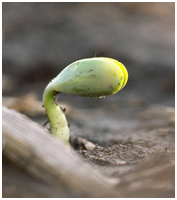Benefits of Using a Starter Fertilizer for Soybean Production

Starter fertilizer can help boost soybean production for better yields.
Earlier planting of soybeans can give growers a jump on production. This approach allows the plant more time to capture light and accrue carbon, nitrogen and other elements necessary for producing seed during reproductive phases. The result is that these soybeans will out-yield later plantings. For instance, Iowa State University researchers have found growers can gain three to four bushels an acre if planting starts the last week of April or the first week of May.
Growers should consider a number of factors when planting early, though. Soybeans don’t like to sit in cold, wet soils. In fact, they are more subject to damage from cold conditions than corn, so producers should specifically monitor soil conditions and the weather forecast for 48 hours after planting. If unfavorable weather is projected, growers should consider adjusting their planting date. The ideal soil temperature for germination and emergence is between 77° and 86° F, but soybeans will germinate at soil temperatures of 50° F.
“Yield data shows that soybeans can take a slight hit in stand without affecting yields – so the advantage of early planting can prevail,” says Dr. Jerry Wilhm, senior research manager with Agro-Culture Liquid Fertilizers. “Careful in-furrow application of phosphorus and potassium can help during these early conditions by encouraging root development. The roots will then grow nodules that fix nitrogen from the soil.” Nodules on healthy soybeans form following infection by the nodulating bacteria around the V2 stage.
Prescription Application Based on Trials
AgroLiquid research shows that row-applied fertilizer applications increased no-till soybean yields – almost 5 bu/A – over a no-fertilizer check (NCRS11-307). Researchers here used Pro-Germinator™ + Sure-K™ + Micro500™. Pro-Germinator™ contains a high quality, dual form of phosphate fertilizer with multi-forms of nitrogen, while Sure-K™ is a chloride- and hydroxide-free potassium fertilizer.
In permanent plot rotation trials, researchers compared liquid to conventional dry potash (0-0-62). A combination of Sure-K™ and Micro500™ yielded 1.5 to 4.5 more bu/A than two different rates of dry product (NCRS11-714).
AgroLiquid’s P and K Recommendations for Early Soybeans
Apply 1 to 2 gallons/A Pro-Germinator™ + Sure-K™ plus (based on soil test K findings), along with 1 to 2 quarts/A Micro500™. “Root zone banding in 30-inch row beans can result in seedling injury at rates above 3 gal/A in light-textured soils,” cautions Wilhm. “The risk goes down in 15-inch rows, and there is little chance of seedling injury with soybean fertilizer programs in drilled soybeans.”
If there is a need for more than 3 gallons/A of fertilizer in 30-inch row beans, growers can apply the Pro-Germinator™ and Micro500™ at planting (3 gal/A max in light soils), then the balance of Sure-K™ as a foliar application.
Experts agree that soil testing is a key component. Iowa researchers recommend basing soybean fertilizer applications on soil test levels and estimates of nutrient removal by the crop. To help with those calculations, they note that a bushel of soybeans removes approximately 3.8 pounds of N, 0.8 pounds of P and 1.5 pounds of K each season.


Hello,
My name is Wes mcgennis I farm with my dad Gary. We have a goal to raise 100 bushel soybeans on our farm in southern Indiana. We currently have a APH of 45 bushel. How can we achieve this goal?
Hi Wes,
To achieve higher yielding soybeans a grower should at feeding the crop through several different methods. The first thing a grower should look at would be to try and get soil pH levels to ideal ranges for growing soybeans (6.8-7.4). The second thing to consider would be what the article above discusses where you look at soil analysis and use a 1-3 gallon per acre blend of needed nutrients to help establish the crop. The third would be to look at foliar applications during the vegetative growth cycles to optimize plant growth and continue root development. The fourth would be to look at more foliar applications during the reproductive growth cycles to increase bloom development and retention.
Foliar feeding applications should be formulated from looking at soil analysis, tissue analysis, and visual observations. Then take into consideration the current growing conditions and possible stress factors to help determine the plant needs. Best results are usually seen when growers use a 2-3 gallon rate of nutrients and are applied in a manner where total solution doesn’t exceed 10 gallons. Normally reapplications of foliar nutrients should not be made before 14-21 days from the previous application. Lastly applications should be made with higher pressure to help the nutrients be uniformly applied to both sides of the leaves.
To help determine your nutrient needs contact our Sales Account Mgr. for Indiana Adam Beck his email is Adam.Beck@agroliquid.com
Thanks